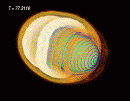Neutron Star Coalescences
Mark Miller, Wai-Mo Suen and Malcolm Tobias, NCSA/Potsdam/Washington U Collaboration
 General Relativistic Astrophysics---astrophysics that involves strong and dynamical gravitational fields requiring the full Einstein equations for its understanding---is becoming a promising research area, due to the large amount of data in high energy astronomy, and to the great promise of gravitational wave astronomy made possible by the Laser Interferometer Gravitational Wave Observatories, LIGO/VIRGO and LISA. In particular, Computational General Relativistic Astrophysics, with the recent stunning increases in computer power, may hold the key to the understanding of many observations in high energy astronomy and gravitational wave astronomy.
General Relativistic Astrophysics---astrophysics that involves strong and dynamical gravitational fields requiring the full Einstein equations for its understanding---is becoming a promising research area, due to the large amount of data in high energy astronomy, and to the great promise of gravitational wave astronomy made possible by the Laser Interferometer Gravitational Wave Observatories, LIGO/VIRGO and LISA. In particular, Computational General Relativistic Astrophysics, with the recent stunning increases in computer power, may hold the key to the understanding of many observations in high energy astronomy and gravitational wave astronomy.
We show a simulation of two neutron stars in a grazing collision based on the full Einstein equations coupled to general relativistic hydrodynamic equations. The coalescences of neutron star binaries have attracted much attention as sources of gravitational radiation and candidates of gamma-ray burst.
The simulation is carried out with a 3D code called "Cactus" that is currently being developed by our NCSA/Potsdam/Wash U Numerical Relativity Collaboration, together with other research groups in the community. The study of neutron star coalescences is performed as part of the NASA Neutron Star Grand Challenge Project (NASA HPCC NCCS5-153). The computation is carried out at the NSF SuperComputing Centers under National Resource Allocation MCA 93S025.
